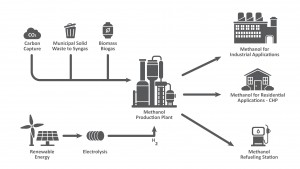The global demand for methanol continues to change and grow. According to available data, methanol use as fuel is increasing, with the United States leading as a worldwide exporter as of 2023. According to the Methanol Institute, methanol is a chemical building block used for hundreds of everyday products, including enamel coatings, adhesives, and synthetic rubber.
As the production and use of methanol increases, two potential concerns related to rubber seals may arise in:
- Existing seals in older applications where the addition of methanol may cause the rubber to swell
- Sealing process equipment used in the production of methanol
Methanol affects different polymer grades with respect to volume swell. For sealing applications, it is critical to have the correct polymer that allows for a given amount of volume swell. Specifically, in this article, we will be focusing on our Nitrile-Buna (NBR) compounds.
At present, the seal industry’s most widely used and economical elastomer, Nitrile (NBR), combines excellent resistance to petroleum-based oils and fuels, silicone greases, hydraulic fluids, water and alcohols, with a good balance of desirable working properties such as low compression set, high tensile strength and high abrasion resistance. One limitation is that NBR is attacked by ozone, so seals exposed to the environment will have a shorter service life due to deterioration caused by ozone to the polymer. Hydrogenated NBR (HNBR) provides better ozone resistance and higher temperature ranges because the polymer is more stable. The typical temperature range of a standard NBR is -40 ℉ to +257℉ (-40℃ to 125℃).
To determine the volume swell due to methanol exposure of our various NBR compounds, we tested three of our most common NBR with different acrylonitrile (ACN) content. The composition of Nitrile (Buna-N) Rubber can be better explained in a previous hot topic, Understanding the Composition of a Nitrile (Buna-N) Rubber Compound. Our 11BN7AP (40% ACN), 27BN7AP (33% ACN), and 14BN7AP (14% ACN) were submerged for 168 hours (1 week) at 23 ℃ in methanol.
The ACN content of an NBR significantly affects its properties, including:
- Low Temperature Flexibility: Lower ACN content improves flexibility at low temperatures
- Oil and Chemical Resistance: Higher ACN content improves resistance to fuels and polar lubricants
The results of the volume swell are shown below in Table 1, as well as their typical service temperature. It can be observed that a 14% ACN compound can perform at -60℃, while a 33% can perform at -40℃, and a 40% ACN can perform at temperatures as low as -25℃. Typically, 10% of an NBR compound consists of plasticizers which can be extracted. This results in a volume loss as seen in our 14BN7AP compound.
Have questions about our compounds? Contact our engineers for assistance.

